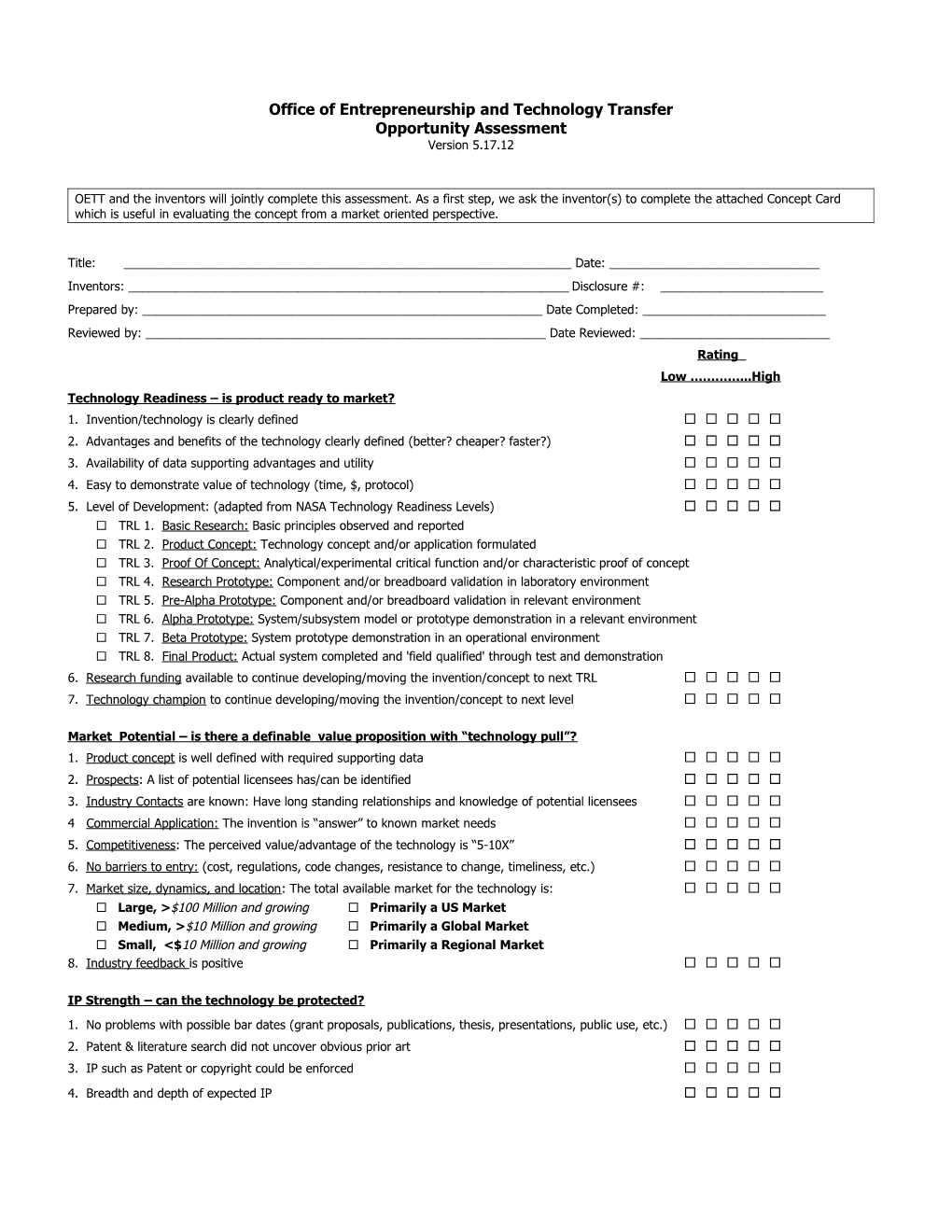Office of Entrepreneurship and Technology Transfer
Opportunity Assessment
Version 5.17.12
OETT and the inventors will jointly complete this assessment. As a first step, we ask the inventor(s) to complete the attached Concept Card which is useful in evaluating the concept from a market oriented perspective.
Title: ______Date: ______
Inventors: ______Disclosure #: ______
Prepared by: ______Date Completed: ______
Reviewed by: ______Date Reviewed: ______
Rating
Low …………...High
Technology Readiness – is product ready to market?
1. Invention/technology is clearly defined
2. Advantages and benefits of the technology clearly defined (better? cheaper? faster?)
3. Availability of data supporting advantages and utility
4. Easy to demonstrate value of technology (time, $, protocol)
5. Level of Development: (adapted from NASA Technology Readiness Levels)
TRL 1. Basic Research: Basic principles observed and reported
TRL 2. Product Concept: Technology concept and/or application formulated
TRL 3. Proof Of Concept: Analytical/experimental critical function and/or characteristic proof of concept
TRL 4. Research Prototype:Component and/or breadboard validation in laboratory environment
TRL 5. Pre-Alpha Prototype: Component and/or breadboard validation in relevant environment
TRL 6. Alpha Prototype: System/subsystem model or prototype demonstration in a relevant environment
TRL 7. Beta Prototype: System prototype demonstration in an operational environment
TRL 8. Final Product: Actual system completed and 'field qualified' through test and demonstration
6. Research funding available to continue developing/moving the invention/concept to next TRL
7. Technology championto continue developing/moving the invention/concept to next level
Market Potential – is there a definable value proposition with “technology pull”?
1. Product concept is well defined with required supporting data
2. Prospects: A list of potential licensees has/can be identified
3. Industry Contactsare known: Have long standing relationships and knowledge of potential licensees
4 Commercial Application: The invention is “answer” to known market needs
5. Competitiveness: The perceived value/advantage of the technology is “5-10X”
6. No barriers to entry: (cost, regulations, code changes, resistance to change, timeliness, etc.)
7. Market size, dynamics, and location: Thetotal available market for the technology is:
Large, >$100 Million and growing Primarilya US Market
Medium, >$10 Million and growing Primarily a Global Market
Small, <$10 Millionand growing Primarily a Regional Market
8. Industry feedback is positive
IP Strength – can the technology be protected?
1. No problems with possible bar dates(grant proposals, publications, thesis, presentations, public use, etc.)
2. Patent & literature search did not uncover obvious prior art
3. IP such as Patent or copyright could be enforced
4. Breadth and depth of expected IP
Summary of key issues identifiedin the Opportunity Assessment
What are biggest concerns or challenges:
Potential return or value over lifetime of patent or copyright (sponsored research, royalties, fees, equity, etc.)
Probability of Obtaining a LicenseNot ready / Low / Medium / High / Dormant
Potential Return
>$5M
$1M - $5M
< $1M
Field Agriculture Bio Tech & Biological Sciences Engineering & Physical Sciences Other
Recommendations - Patent and Copyright Protection
Review with patent attorney necessary
Protect Technology
____ Protect with Confidentiality Agreement____ Recommend provisional patent application be filed
______Refile provisional patent application /
____ Recommend utility patent application be filed
____ PCT Application under consideration
____ Recommend copyright registration be filed
______will fund the patent applications.
Additional information requested from Inventor(s). Process as new disclosure when information received.
Close - Prepare letter to Inventor with copy of assessment and close file.
Recommendations - Marketing
Initiate/continue marketing phase after technology is protected.
- Create marketing content, list of potential licensees, market analysis, etc.
- Contact prospects - surveys have shown that most licensees are known to the inventor/colleagues.
Not Ready - potential for commercialization but no immediate prospects.
- Review cost/benefit of protecting technology.
- Initiate passive marketing while technology is under development and/or protected
Close - No clear path to market or feed back has been negative. Prepare letter to Inventor and close file
Concept Card*
Concept Name
Suggestive of Benefits
Explain your idea in two sentences or less
Use laymen’s terms to describe the licensable product.
Who is the Target Customer? &/or What is the Customer Problem?
1. DRAMATIC Difference: Why should I care? (I the customer)
What is the NEWS HEADLINE? What is the WOW for the customer?
2 Overt Benefit Promise: What’s in it for me? (me the customer)
Details on the specific advantages we are promising the customer is…(estimate numbers)
3. Real Reason to Believe: Why should I believe you? (I the customer)
The truth about HOW IT WORKS &/or HOW we are able to deliver on the\is promise
Added credibility: Specific testimonials, technologies, data or guarantees
*Used with permission of Eureka Ranch Technology Ltd. The Concept Card was developed by Doug Hall of Eureka Ranch Technology Ltd. Since 1986, his Eureka! Ranch consulting team has helped corporations such as American Express, Nike, Procter & Gamble and Walt Disney discover Measurably Smarter Choices for Growth. It seems to work – the Ranch has a world-class 88% client repeat rate.
Today, in addition to continuing to help corporate clients, Doug is on a mission to bring the Eureka! Ranch technologies to real world entrepreneurs. He’s developed a new licensed offering called Eureka! Winning Ways that helps small and mid sized businesses discover measurably smarter choices for growth.
Doug is the author of four best selling books and a popular speaker on sales, marketing, creativity and innovation. He has also hosted and starred on a wide range of network radio and television programs.(from
1
